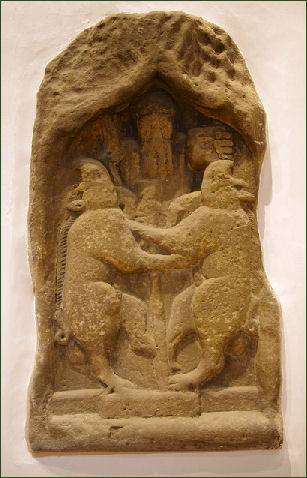St. Mary's Church, Barnard Castle
OS grid reference:- NZ 051 162
Historic St Mary's Church stands in the centre of the town of Barnard Castle, opposite to the market cross and has connections with Richard III, the most controversial of English kings. The church was founded in around 1130 by Bernard de Balliol, the second known ruling Balliol of his line, who built the nearby castle, from whom the Castle and surrounding town derive their name.


The original Norman church consisted of a much simpler building, with of an aisleless nave and a long chancel. The church had originally served as the castle's chapel, but later became parish church for the town which began to develop around it. The living was granted by Balliol to St Mary's Abbey in York. Ballioil's youngest son, Bernard de Balliol II, famous for his role in the capture of William the Lion, King of the Scots, near Alnwick in 1174, added the north aisle with its stark Norman columns in around 1150s. The church has been rebuilt and extended over the years and only the north aisle arcades remain of Balliol’s church.
 The tall battlemented tower was built in 1270, entrance to the building is through the south door under the tower, into a porch which contains a lot of memorials on the walls including a memorial plaque to Captain Augustus Webb, who was fatally wounded during the Charge of the Light Brigade during the Crimean War. In the north aisle is a memorial to the men of the Durham Light Infantry who died in the South African wars of 1899-1902. Nearby is a blocked doorway that once gave access to the north porch, which was built by Richard, Duke of Gloucester, later to reign as King Richard III.
The tall battlemented tower was built in 1270, entrance to the building is through the south door under the tower, into a porch which contains a lot of memorials on the walls including a memorial plaque to Captain Augustus Webb, who was fatally wounded during the Charge of the Light Brigade during the Crimean War. In the north aisle is a memorial to the men of the Durham Light Infantry who died in the South African wars of 1899-1902. Nearby is a blocked doorway that once gave access to the north porch, which was built by Richard, Duke of Gloucester, later to reign as King Richard III.
Richard, Duke of Gloucester, lord of the manor at Barnard Castle, widened and extended the church in 1480 and added the clerestory windows. The chancel arch was also built at this time. On one side of the arch is a carved head that may represent his older brother King Edward IV, and on the other a very worn head believed to be of Richard III. The Yorkshire rose is carved on the stones round the arch. In the chancel itself is a Jacobean communion table dating to the early seventeenth century.
In the north transept are two recessed tomb niches which were added in 1380, one of these contains the fourteenth century recumbent effigy of the priest Robert de Martham, vicar of Gainford. The other niche has the fourteenth century carved grave slab of a priest, decorated with a floriated cross. Set on the wall nearby is a fragment of a fourteenth century sculpture depicting St Anthony the Egyptian Eremite, flanked by a pair of upright boars, which may have formed part of a larger tombstone.
The bulding also contains an extremely large and unique marble font, which dates back to fifteenth century. This enigmatic font was constructed in around 1485. It bears carved symbols on shields arranged on each face and on the base. The meaning of the symbols is not known however, they may be medieval guild insignias.
Abbeys and Churches of Yorkshire
Historic Buildings of Yorkshire
